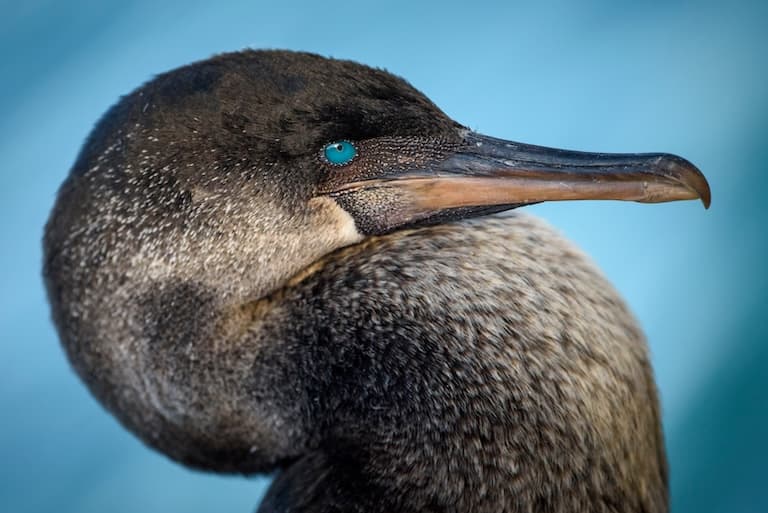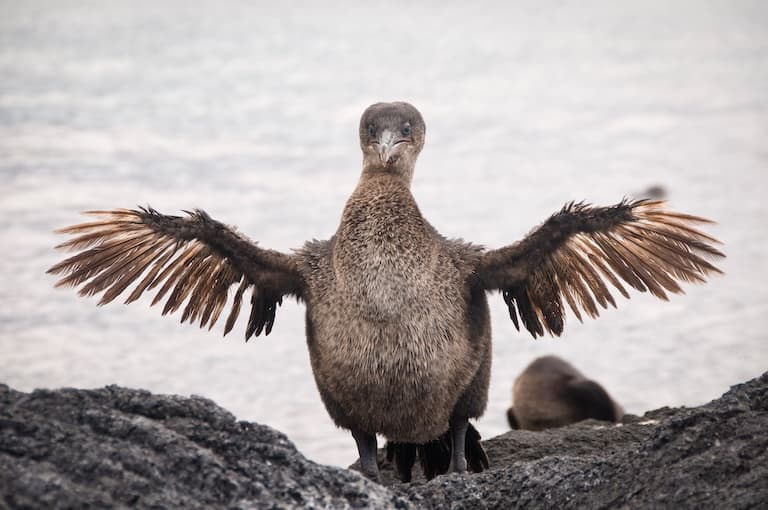Flightless Cormorant Profile
Cormorants are some of the commonest water birds found on both coastlines and rivers, found all over the world. They’re instantly recognisable by their long wings and skinny bodies and produce a single yearly clutch.
But the flightless cormorant has gone against the grain on all fronts, and since the extinction of the Spectacles cormorant in around 1850, this is now the largest cormorant, and next in line for extinction.

Flightless Cormorant Facts Overview
| Habitat: | Volcanic islands, coastal |
| Location: | Galapagos Islands |
| Lifespan: | Around 13 years |
| Size: | Up to a metre (39.5 in) long |
| Weight: | Up to 5 kg (11 lb) |
| Colour: | Black on the back, brown on the front |
| Diet: | Fish, cephalopods, eels, other small marine life |
| Predators: | Only invasive animals: cats, dogs, pigs |
| Top Speed: | Unknown |
| No. of Species: | 1 |
| Conservation Status: | Vulnerable (IUCN) |
Conservationists are doing great work with the fauna on the Galapagos Islands, despite its apparent lack of concern for its own safety.
The flightless cormorant isn’t really afraid of anything, and this was fine when it landed on an unpopulated island and lost its ability to fly, but with the influx of introduced animals, they’re now in significant danger.
Interesting Flightless Cormorant Facts
1. Boobies
The Suliformes are an order of seabirds that contains some of the coolest fish-eating animals with wings. This order also contains the most species to elicit snickering in the classroom.
In this order are the strikingly coloured gannets, the serpentine snake birds, and the easiest species to type upside down on your calculator: the boobies. The inflatable frigatebirds are the oldest family in this order, and the youngest are the cormorants and another group that never loses its charm, the shags.
These two groups aren’t very distinct, and there seems to have been a missed opportunity when naming the “great cormorant”, but that’s besides the point.
All but one of the 42 species in this family are flighted birds, adept at diving, though all but one have some of the highest flight costs of any flying bird. The exception, of course, is the flightless cormorant – the one species that gave up on flight altogether. 1
2. Flight would be a disadvantage
Flying is one of the things birds are well known for, but there are several cases where they’ve chosen to abandon it. Ostriches replaced flight with running, penguins replaced it with swimming, and likewise, the flightless cormorant has chosen a life of diving over a life of soaring.
You’d think maybe it would be better to do both, but not always. The very nature of flight feathers means that they hold onto air, which would make diving harder, and the better the wings become at diving, the worse they are for aerial manoeuvring.
And when you don’t need to fly, you can get as fat as you like. 2
3. They’re huge!
This is the largest cormorant species on Earth, at around a metre long and up to 5kg in weight. Its wings have also reduced in size and would be far too small to lift an animal this chunky off the ground, even if it wanted to.
The ridge on the breast, where flight muscles would usually attach, has atrophied from disuse, and they have become plumper, but more streamlined for diving in water from the surface. Most of these dives are above the first 20 metres, but they have been seen as deep as 80 metres beneath the surface.
Getting fatter also makes them slower on the land, but these birds evolved in the absence of danger.
4. They have no natural predators
Another related factor to the flightlessness of these birds is the lack of predators. Arboreal life is great for avoiding terrestrial predators, and flight is a huge advantage to arboreal life, but when a species gets lost in a storm and ends up on an island with no dangers and few, if any trees, flight becomes a bit redundant.
The Galapagos islands are young, by geological standards, some only a million years old, and the oldest no more than five million years old. And birds, as some of the most mobile animals were likely some of the earliest to arrive – before anything that eats birds.
This allowed them to quit flying and wander around without worries. But without worries, fear also becomes redundant.
5. They’re fearless

Hollywood is well known for setting a terrible standard for what normal people are supposed to look like, but action movies set unrealistic impressions of how they’re supposed to feel.
Heroes walk through a hail of bullets without flinching, and main characters would never be so weak as to look back at explosions. What they’re depicting isn’t the attainable quality of bravery, it’s simple fearlessness – an unrealistic and dangerous expectation.
True bravery requires fear, and without it, an organism is profoundly vulnerable to threats. But fear is an evolved response to danger, and we often see, in island ecosystems where there are no natural predators, fear – like any attribute that’s not being used – will reduce, and eventually disappear entirely.
The flightless cormorant is a perfect example, and visitors to the island can simply walk up to them. This is fine when it’s well-wishing tourists policed by a guide with a gun, but not ideal when it’s a hungry pig. 3
6. Invasive species take advantage of this
Flight is also great for dispersing, and dispersing is great at reducing the effect of the “All your eggs in one basket” phenomenon.
But with no natural predators, you can keep as many eggs in as few baskets as you like and you’ll probably be fine. Consequently, the flightless cormorant has become complacent in its efforts to spread out and remains relatively unfazed by the old adage.
But what happens when a hairless ape brings a whole bunch of its predatory kin along with it to inhabit the islands? Well, the flightless cormorants are finding out. They are now inundated with pigs, cats, rats and dogs, all of whom now only need to find one basket to ruin the day.
The young islands are still in the throes of the volcanic activity that created them, and eruptions also pose a threat to localised populations, but even in the face of several threats, the species is doing remarkably well.
7. They are still very successful
The annual survival rate for both males and females is still around 90%, which is remarkable, considering the new dangers.
Still, this isn’t as much a symbol of their resilience as a testament to conservationists who are essentially doing the job of the parent of a toddler who doesn’t understand not to crawl through a third-storey window.
However, the strength of the population coupled with the conservation efforts being employed has led to this rare bird species being bumped up to Vulnerable by the IUCN, and the population is now considered stable.
This is still one of the world’s rarest birds, and the threats are still present, but with continued support, hopefully, it can repopulate its home.

Flightless Cormorant Fact-File Summary
Scientific Classification
| Kingdom: | Animalia |
| Phylum: | Chordata |
| Class: | Aves |
| Order: | Suliformes |
| Family: | Phalacrocoracidae |
| Genus: | Nannopterum |
| Species: | Harrisi |
Fact Sources & References
- Christopher Klassen, “The Evolutionary Mystery of the Flightless Cormorant in Galapagos”, La Pinta Galapagos Cruise.
- “Flightless Cormorant”, Animalia.
- “Flightless Cormorant”, IUCN Red List.
